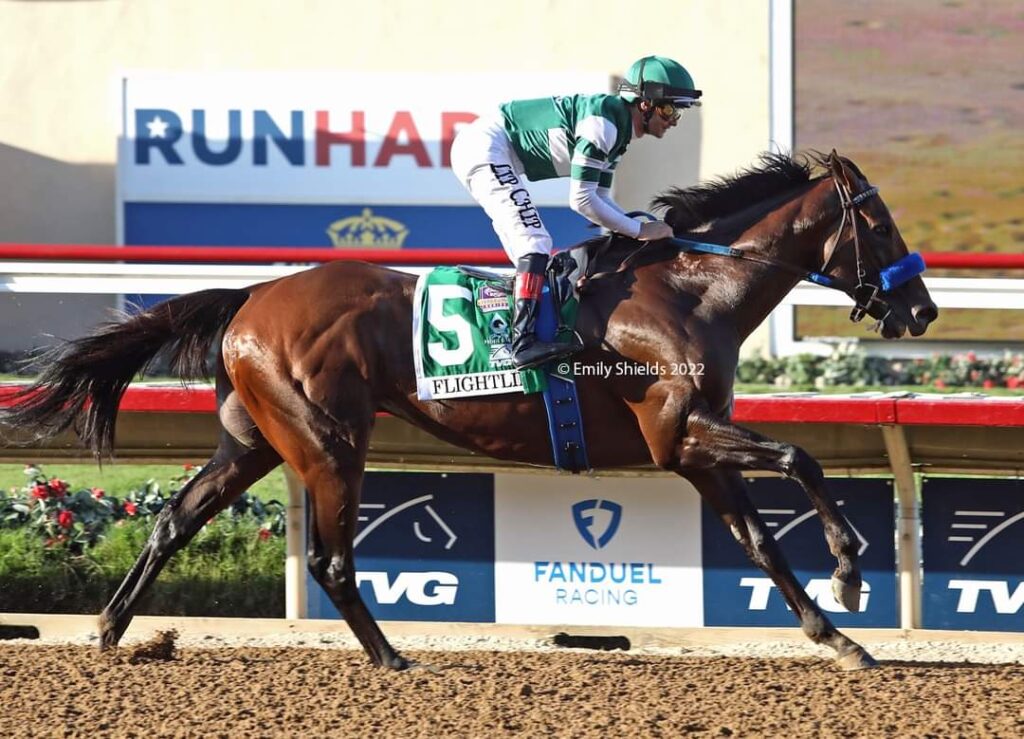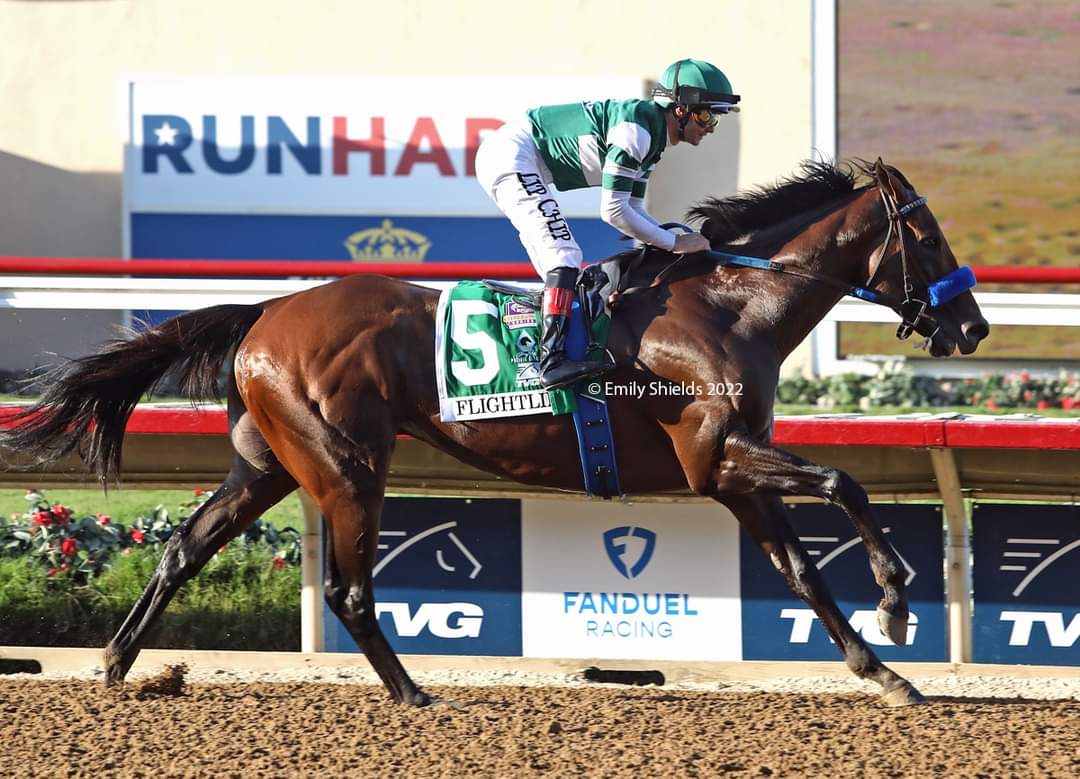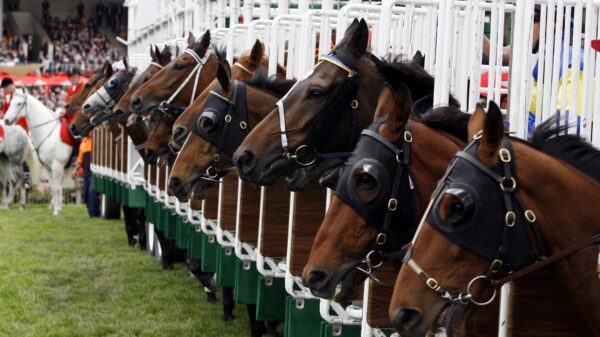THE HISTORICAL PERSPECTIVE FOR GETTING INTO THE RACING HALL OF FAME

Rinaldo Del Gallo, III
By: Rinaldo Del Gallo, III
When we look at Flightline, we should consider his record and compare him to other racing greats. Flightline started a mere 6 times in his life—shockingly few races. I had thought Ghostzapper and Regret’s 11 races is the record low for races to get in the Hall of Fame. However, my research indicates that there have been other horses with fewer starts than 11 in the Hall of Fame. There are also 3 other horses in the Hall of Fame that only have 11 starts (Ruffian, American Pharoah, AP Indy). Horses used to race much more often in the early part of the 20th Century, but remarkably, there are 19th Century horses that have made it to the Hall of Fame with 10 or less races. But there are a few—precious few—horse that have made it into the Hall of Fame with less than 10 starts.
To date, 220 horses have been inducted into the Hall of Fame. Only 5 of those 220 horses have less than 10 starts, and none have less than seven. According to the National Racing Hall of Fame, Hall of Fame members Sir Archy (born 1805) has 7 starts, Lexington (br. 1850) has 7 starts, Artful (b. 1902) (the only horse born in the 20th Century and just barely) has 8 starts, American Eclipse (b. 1814) has 8 starts, and Commando (b. 1898) has 9 starts. And that’s it for the under 10 starts crowd.
There is one horse, Majestic Prince, with just 10 starts. There are 6 horses in the hall of fame with just 11 starts. There is one horse—Invasor—with only 12 starts. In other words, if we double the number of times Flightline (and Justify) ran—6 races, and then doubled it, only 13 of those 220 horses in the Hall of Fame don’t have more than double the amount of races that Flightline or Justify ran. I cannot possibly understate the historical record. Modern horses with less than ten starts are not put in the Hall of Fame, for their accomplishments are considered too few, even if the few races they ran were magnificent.
The National Museum of Racing and Hall of Fame will have to make a decision—whether to allow horses such as Flightline or Justify that only have 6 races under their belt. Candy Ride (b. 1999) started 6 times and won 6 times, including a Pacific Classic that was better than Flightline’s. But presumably, the fact that he only won two stakes races in America have kept him out of the Hall of Fame.
It is to be conceded that Flightline is a great horse. But he only ran three times this year, the Met Mile on June 11th, and then he started in the Pacific Classic on September 3rd of this year, two months and a 23-day gap—just shy of three months. Then there was just a little over a two-month gap between the Pacific Classic and the November 5th Breeders’ Cup Classic.
Horse racing is an industry with many problems. There is increased concern about animal safety, and I have to admit I am in that camp. But the other major problem is both the lack of number of starts and years cut short by the stars in the sport. I don’t blame the owners for the early retirements, Hronis Racing, LLC (Kosta Hronis), Summer Wind Equine, LLC (Jane Lyon), and West Point Thoroughbreds (Terrence Finley), et al who own Flightline. Very often when you invest in a horse, maybe you don’t get a Green Monkey (a failure of historic proportions considering what was invested in him), but you get a horse that went for half a million dollars and ended up in 30 thousand dollars claimers. So, when your horse makes it, you have to see a profit to make up for all the horses that proved to be duds.
Yesterday (as I write this), Flightline’s retirement was announced. Today as I write this, November 8, 2022, a mere 2.5% interest in Flightline sold for 4.6 million dollars! 2.5% is 1/40th of the value of the horse, or $184 million if the buyer bought the whole horse at the same rate. By way of comparison, Ghostzapper has progeny that have earned $100,575,825 according to Bloodhorse. The same publication has Tapit with progeny earnings of $177,453,038 in his 13 crops. Obviously, a stud fee is not remotely the only cost of a horse—you have to pay for the mare, the trainer, the feed, the vet bills, and the travel cost.
And who knows if Flightline will be a Smarty Jones—a horse that started off with a stud fee of $100,000 and now has a stud fee of $3,500. According to Bloodhorse, in an article published in 2004, “The 60 shares in Smarty Jones are valued at $650,000 each, making for a total value of $39 million.” Who knows why certain horses don’t make—Smarty Jones’ sire is Elusive Quality, and Elusive Quality’s son Quality Road will stand for $200,000 per year in 2023. But Smarty Jones fee plummeted. According to that 2004 Bloodhorse article, “The agreement also specifies that the book of mares bred to Smarty Jones will be limited to 110 mares, plus a Breeders’ Cup nomination, and that he will not be shuttled to the Southern Hemisphere for breeding purposes.” At $100 K per mating (assuming all were in foal), that would result in Smarty Jones commanding $11,000,000 in stud fees his first year alone: Smarty Jones earned $7,613,155 on the track. Smarty Jones, a horse that won the Kentucky Derby and Preakness is not in the Hall of Fame—presumably because he only started 9 times.
Why do they put horses out to stud so quickly? To anyone remotely familiar with the industry, as these previously described numbers indicate, while purses can be rich at some of the world’s greatest horse races, they are nothing compared to stud fees. To be candid, I am not sure the cost of horses are justified in their earning potential running, and I have always wanted to compare stallion fees, sales cost with their actual earnings at the racetrack. Even more so, I have always wanted to compare auctions sales with actual purse money at racetracks and have attempted to do so in this opinion piece.

Flightline
Photo Credit: Emily Shields
But again, 2.5% of Flightline sold for $4.6 million dollars. The winner of the Breeders’ Cup Classic earned 52% of the $6 Million dollar purse, or $3.12 million. Let that sink in. Flightline’s lifetime earnings of $4,514,800 is less than the price fetched for 2.5% of the horse at auction of 4.6 million dollars! That should make it abundantly obvious why Flightline was put out to stud. Horses don’t just make more money at stud—the very top horses make astronomically more money at stud.
American Pharoah bred 208 mares his first year at $200,000 for total net sales of $41,600,000. By way of comparison, American Pharoah had lifetime earnings of $8,650,300. You get the arithmetic—even if a horse won the $20 million Saudi Cup, and the $12 million Dubai World Cup, the $3 million dollar Pegasus, and the $6 million dollar Breeders’ Cup Classic, one could not possibly earn the amount American Pharoah commanded in his first year at stud. In fact, even if these races were winner-take-all events, which they certainly are not, it would only be $47 million total purse money compared to $41.6 million of total stud fees for American Pharoah’s first crop. So, anybody that is even slightly handy with a calculator and knows the stud fees and the number of mares possibly bred can calculate why horses are taken out of training.
In my opinion, people pay too much for racehorses and stud fees and I suspect in the aggregate the average person loses money. Regardless, it is a lot more fun to invest in a racehorse as compared to a parking garage and investing in racehorses will have a natural appeal far greater than a horse’s actual potential to earn—that’s just my opinion, but I don’t have all the data. But let me take a stab. According to Bloodhorse Magazine, so far, there have been over 1 Billion in sales of racehorses this year so far. Last year it was 1.154 Billion. This year it is about $1.049 billion in total sales of horses as of this writing. According to Blood Horse, “Racing’s most successful pari-mutuel year in more than a decade and continued funding from outside sources—most notably money committed to racing from added-gaming—saw United States purses reach a record $1.18 billion in 2021.” 1.18 billion in purses versus 1.154 billion in sales of racehorses and the year is not even over? Don’t forget, there are people that breed their own racehorses and don’t purchase them at auction. And there are horses that don’t fetch the reserve price at auction. And the 1.18 billion in purses versus 1.154 bill in sales also only reflects total purchase prices in the United States versus total purses in the United States—it doesn’t reflect training cost, vet bills, feed, shelter cost, and travel expenses. Nor does it include the cost of horses already invested in for people that breed their own horses and don’t sell them. So you continue to get more investing in racehorses as compared to parking garages even if that fees spent on racehorses does not seem worth it, and that makes stud fees go upward. And this makes people want to put their horses to stud.
https://www.Bloodhorse.com/horse-racing/thoroughbred-sales/state-of-the-market
KILLING THE GOOSE THAT LAYS THE GOLDEN EGG
I suppose to the super rich, it might be fun to just own a fast racehorse. But let’s face the obvious—the only reason thoroughbreds have value is their potential to earn at racetracks. And racetracks only have the potential to offer purse money through a betting public, whether it be on computers or off-track betting, or people who show up at the racetrack (and bet, buy concessions, and pay the entrance fee), and to a certain degree television rights. If you make a less interesting product, that will be reflected in gross receipts. There is a cost of having a less exciting sport.
Years ago, in the first half of the 20th Century, horse racing was one of the biggest sports in America. Seabiscuit was constantly in the news. When Seabiscuit had a match race against War Admiral, it was on the front pages of newspapers everywhere. Horse racing is not the only sport that has taken a nosedive—boxing was once very popular. However, I bet you do not know who the boxing heavyweight world champion is. (I do not.) Horse racing occasionally can have a spotlight put on it. Zenyatta made 60 Minutes. The 60 Minutes story aired October 31, 2010, just before her run at the Breeders’ Cup Classic. But those 60 Minute type moments are far and between. When you have the stars of the sport dropping out early to make the big bucks as stallions, it just wrecks all the fun and interest.
Of course, it isn’t just that Flightline is retiring—he hardly ran. He literally ran only 6 times. He only ran 3 times this season. As a fan, I am sick of watching great race after great race not attracting the best fields. The one-million-dollar Jockey Gold Cup in Saratoga, held on September 3, 2022, could not attract Life is Good, who last raced in the August 6th Whitney, just a few days short of a month’s rest. This too is ruining the sport. Horses that run in the Kentucky Derby now routinely skip the Preakness, even if a horse is very good.
In the past, I remember going to Saratoga to see Affirmed v. Alydar when I was a teenager (I have written columns about the experience), and later in life going with my father to see Rachel Alexander run in the Woodward against older horses some 31 years and 18 days years later. Horse racing is about stars and rivalries. For rivalries to develop, horses have to race.
https://www.saratogian.com/2009/06/20/readers-view-a-dadtravers-tradition/
When great horses keep running, they can lose. Arrogate made the audacious jump from an allowance optional claiming race to the Travers of 2016, which he handily won. Then he won the 2016 Breeders’ Cup, the 2017 Pegasus (it has $12 million dollar purse that year, then the world’s richest horse race) and then Arrogate won the 2017 Dubai World Cup in a shocking manner from way back in the pack to the front—he was a horse that used to like to take the early lead and it was a stunning comeback. The track announcer compared him to Man O’War. But when Arrogate came back to the states, he was only 4th in the San Diego Handicap, 2nd in the Pacific Classic, and was a distant 5th in the 2017 Breeders’ Cup Classic. Would there be chinks in the armor of Flightline? I don’t know, but as a racing fan I would have certainly liked to have found out.
THE SOLUTION: AN EIGHT-YEAR RULE
So, what can racing do about it? The major tracks could simply agree that horses that race there have to have been sired by horses at least eight years old. (A younger age can be picked, but again, horses can be competitive up to age seven.) I suppose you can tell me that we should not be able to tell horse owners what to do with their horses. After all, the horse is their property. But horse owners do not have a right to ruin the sport. Common values for the benefit of all should be a given. One of these values is to make the racing product—and it is a product—more interesting and enticing to consumers. Racehorse owners should want the general public to want.
However, putting horses out to stud rather than extended campaigns will result in a more boring sport. It matters that Spectacular Bid had a four-year old season. A more boring sport translates eventually into less betting, less gate receipts, and less of a price commanded for television rights. Less people will be interested in the sport. As mentioned, already, we have horses not running that much in a single season, and it is already a practice for horses that ran in the Kentucky Derby to not run in the Preakness, which never happened in decades past. This year the horse that actually won the Kentucky Derby skipped the Preakness. We should expect more out of horses than six races, unless they are too hurt to run.
Horse racing already has problems. It is plagued by animal welfare concerns and by ever more lax rules on casinos, which had resulted in the explosion of casinos and betting alternatives. You can tell me to pound sand and that horse owners should be able to put stallions to stud whenever they want. But putting stars out to stud too soon is to kill the goose that laid the golden egg.
Putting a horse to stud after major wins is nothing new but was relatively uncommon. Governor William Richardson Davie was the 10th Governor of North Carolina and according to Wikipedia, a founding father and even at the Constitutional Convention. He bought Sir Archy after a match race with Bank and immediately put Sir Archy to stud—the theory was nobody else would race him. I believe in those days racetracks did not have “money added” purses and the purse was largely the stakes of those that owned the racehorse. So, retiring a horse made sense way back then, since it might be hard to get actual races since people had to put up their own money to race against great racehorses. That historical exception aside before “money-added” stakes when owners were not forking up all the money for the purse, putting perfectly sound horses to stud prematurely is a relatively modern phenomenon. Once there were racetracks with conventional stakes races as we know them today, owners simply didn’t put healthy horses to stud while they were still in their prime. After money was added to the purses in the 19th century by racetracks, healthy horses that were stars only stopped racing when they were young if they had soundness issues.
Recently, Arlington closed—a major horse track. Hollywood Park has closed. In Massachusetts, Suffolk Downs closed and the Massachusetts fair circuit, once thriving, is now completely gone. Horse racing cannot cavalierly disregard the wishes of fans for exciting entrants. Interest in horse racing often starts with that one visit to the track to see that great horse or turning on the T.V. to see that must watch race. Forego these opportunities at the industry’s peril. I suppose there will always be diehard fans that would enjoy racing amongst new horses. But sports thrive with stars, with the Hank Aarons and the Babe Ruths and the Bobby Orrs of the world. And the secret to stardom is not a flash of genius, but greatness accompanied by longevity.
I don’t blame the owners for putting Flightline to stud. But I blame the racing industry for letting it happen.
SOME NUMBER OF STARTS FOR HORSES IN THE HALL OF FAME
Affirmed (born 1975)—29 starts, about 10 races per year from 2, 3 and 5.
Alydar (born in 1975)—26 starts in 2 seasons
La Prevoyante (born 1970)—39 Starts in 3 seasons.
Bold n Determined (1977) 20 starts in 3 seasons
Ben Brush (born 1893)—40 stars in 3 seasons
Buckpasser (born 1963)—31 starts in 3 seasons
Citation (born 1945)—45 starts in 4 seasons, literally skipped the ’49 season to race 2 more years instead of going to stud.
Invasor (born) –only 12 starts in 3 seasons, ran only twice in 2007—Donn Handicap and Dubai World Cup.
Colin (born 1905)—ran 15 times (undefeated), only ran 3 times in 1908 and broke down after Belmont.
Myrtlewood (born 1932) –ran 22 times in 3 seasons.
Stymie (b. 1941)—ran 131 times in 5 seasons, he was not a gelding and is in blood of Sunday Silence.
Sysonby (b. 1902)—ran 15 times, died unexpectedly
Ghostzapper (b. 2000)—ran 11 times in 3 seasons, earned a Beyer Speed Figure of 116 in Vosburg at 3, and a 128 Beyer Speed figure at the Philip H. Iselin Breeders’ Cup Handicap at Monmouth Park Racetrack, followed by a 114 Beyer Speed figure in the Woodward, a 124 Beyer Speed figure in the Breeders’ Cup Classic, and then a 122 Beyer Speed figure in the Met Mile, and then he retired. Ghostzapper earned horse of the year honors in 2004 with just 4 starts.
Regret (b. 1912)—11 starts in 2 seasons
Susan’s Girl (b. 1969)—63 starts in 5 years.
Wise Dan (b. 2007)—31 starts in 5 years
Rachel Alexandra (b. 2009)—19 starts in 3 years.
Lexington (b. 1850)—7 starts. (6 wins)
Sir Archy (b. 1805)—8 starts according to some sources (Wikipedia and Racing Hall of Fame.) (Long before major stakes races). Wikipedia has him with a record of 21 Starts: 18–2–1, a markedly different number, but in the body of the article says 7 starts.
American Eclipse (b. 1814) 8 starts.
Artful (b. 1902) 6 starts
Commando (b. 1898) 9 starts
Majestic Prince (b. 1966) 10 starts (career famously cut short after his Belmont run)
American Pharoah (b 2012) 11 starts
Imp (b. 1894) 171 starts (most in Hall of Fame)
Pan Zaretta (b 1910) 141 starts
Parole (b. 1873) 138 Starts. Raced in US and England, winning stakes in both countries. His dam, Maiden, is 6th dam of Nearco.
Kingston (b 1884) 138 states, 89 victories. Thought to be the most victories of any thoroughbred racehorse ever.








